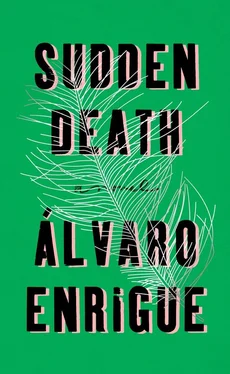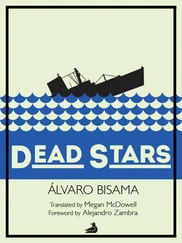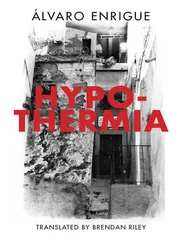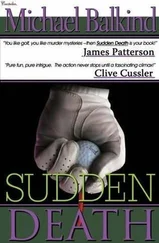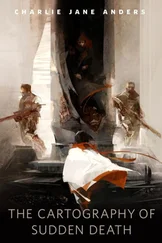There is a sixth head of Caravaggio, sketched ten or fifteen years after his death, in chalk on paper. It was done by Ottavio Leoni, who knew him well. The brown of the eyes, the boldly drawn eyebrows that almost meet at the bridge of the nose, the untidiness of the rather thin beard, the unkempt and chaotic hair, the skin of the face shiny with grease, and the straight nose unblemished by age are the same as in his self-portraits, but in Leoni’s drawing Caravaggio’s expression isn’t theatrical. He looks like what he probably was: difficult, peevish, ready for a fight. His right eyebrow, arched higher than the left, conveys irony and impatience, skepticism. The turned-down mouth signals that he was easily irritated; his slovenliness suggests that he was more arrogant than vain. Most of all, it is the saddest head ever drawn: that of someone already done for, caught in his own trap. The head of someone who no longer has a name of his own.
In March 1595, del Monte bought two paintings from the butcher and art dealer Constantino Spata, paintings by the young artist he had met in Antiveduto Grammatica’s workshop of giant heads. It was so early in his career that they were still signed with the name of his Lombardy boyhood — M. Merixio — rather than the Romanized version of it, Michelangelo Merisi, which he adopted later, or Caravaggio — the town of his birth — with which he signed his works when he became famous.
The cardinal paid eight scudi for The Cardsharps and The Fortune Teller ; four scudi each. In that same year of 1595, the artist Carracci sold his paintings for two hundred and fifty scudi apiece; del Monte’s annual income — not the money he used for his political operations and the administration of the palace, but for his personal expenses — was one thousand scudi. It would have been enough to buy two hundred and fifty Caravaggios a year, twenty-one a month. In 1981, the Kimbell Art Museum in Fort Worth bought The Cardsharps for $15 million.
Despite his spectacular stinginess, Cardinal del Monte always knew exactly what he had bought. He unveiled the two paintings in the celebrated music salon of the Palazzo Madama, where they were so admired by his guests that he soon returned to Constantino Spata’s butcher shop and bought Sick Bacchus and Medusa , which he sent as a gift to the grand duke. In the same fell swoop, carried away by enthusiasm, he bought Caravaggio too — fleshy shoulders, fresh mouth — and brought him to live among the servants of the palace so he could paint works on demand.
This was the turning point of Caravaggio’s career, the moment when his life as an orphan adrift moved him onto the service side of the court.

As it happened, the Lombard really didn’t remember anything about the night before. Very likely he couldn’t even remember each serve as he returned it, once the ball was in play. Maybe this was why he was enjoying himself so much during the break in a match where he had already lost the first set. The spectators had scattered about the gallery to stretch their legs, and some had gone to piss in the canal, so the painter, Mary Magdalene, and Matthew had a bit of welcome privacy.
Leaning on the gallery railing, he wasn’t sure at all how he had come to be playing a Spaniard at tennis, nor why the Spaniard had an escort of soldiers, nor how he could possibly be losing when his opponent was a lame lordling with a face that drooped to the sides, like a pair of buttocks. Not that it mattered much: he was very happy breathing in the powerful scent of Mary Magdalene’s tits as she asked him why the Spaniards could bear arms and his friends couldn’t. They must be noblemen, said the Lombard, and he lowered his head, as if by sinking his nose into the whore’s cleavage he could remove himself from a world that pressed on his temples and parched his throat. He inhaled. And those ugly soldiers, said the woman. The artist turned to look at them. He gave them a distant stare, his eyes nearly shut. They’re green people, he said; except for their master, who’s worse: pink as a pig. And he turned his attention back to her cleavage.
Matthew, who had been in a sulk for a while over the artist’s disinclination to rapidly crush his opponent, noted that they were probably from the Naples regiment, but not soldiers. He added: They must be mercenaries, capo mio —as if he were morally superior somehow to a soldier, a mercenary, or anyone else. He was standing with his back to the court, next to his capo , who was now nuzzling Mary Magdalene’s left clavicle.
If anyone associated with one of the families who ruled the city rabble had heard Saint Matthew refer to the tennis player as capo , he would have died laughing. The artist had the right to carry a sword because he was in service to a cardinal, which meant that he could make extra money by taking part in debt collection and street fights, but that was all. The flock of lowlifes who followed him everywhere wasn’t a gang, though when bodies were needed they brought sticks and stones to the battle for control of a corner or a piazza. The famiglia that the artist belonged to took him seriously because of the lunatic ferocity with which he fought and because of his close ties to the cardinal, who protected him — he never had to spend more than a few hours in jail — but they didn’t consider him trustworthy.
Saint Matthew scratched his ribs. Finally he said: Why don’t we just give him a good beating? The artist sighed and sank his nose between Mary Magdalene’s breasts again. They’re Spaniards, she said; imagine the scandal. She said it in a dreamy way, her smile almost gentle, as if this imagined world weren’t a feast of stabbings and throat-slittings, toward which it made no sense to hurl oneself. There would be war in the streets, she concluded, running her crooked finger across the artist’s neck. If they’re playing tennis with us they can’t be very important, grunted the beggar. I tell you they’re noblemen, it’s risky enough to be playing tennis with them, Mary insisted. Win the match and put an end to it, capo , said Matthew. The artist shook himself a little, exhaled the rather stale air from his lungs into the tart’s cleavage, and lifted his face. Shouting Eccola! as harshly as he might have called for a tavern to be opened at dawn, he went to get his racket and the ball he’d left lying on the pavement. Onlookers, gamblers, and friends found new seats in the gallery as the players changed sides.
Heavily and lazily, the Lombard went through the motions of crossing the court: dragging his feet, his eyes on the ground. Before he had settled himself on the defender’s side, his second rose from his seat under the gallery roof, where everyone thought he had been sleeping, shook out his academic robes, and came to whisper something in his ear. The artist listened, his eyes cast down. For the first time that afternoon, his linesman appeared almost animated: he gestured as he talked. Finally, both of them kneeled on the ground and the mathematician drew lines, crossing some over others; he clapped once. The artist shrugged and the professor returned to his place in the stands to count beams.
The Lombard stopped behind the line, scraped the ground a little, and raised his face, in which a new demonic spirit shone. He half closed his eyes before crying Eccola! once again, this time from the depths where all the rage and violence of which he was capable was accumulated.
Admiralships and Captaincies

Читать дальше
